Navigate the User Hub
The User Hub allows users to build a collage of existing content for the home page of the main client interface for Pyramid. The user hub is defined by the Admin, but each user can edit their own view of the user hub.
- Tabs: click the relevant tab to open it (orange highlight below).
- Reset All:reset all items in the hub to their most recently saved state (yellow arrow below).
- Rerun Queries: run all queries in the hub (green arrow below).
- Edit: edit the hub template (purple arrow below).
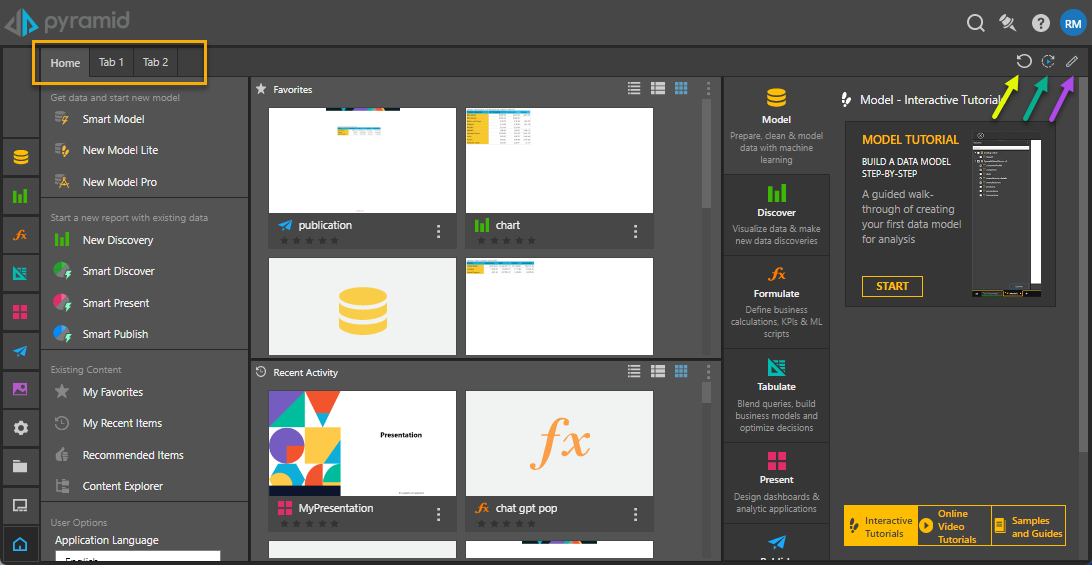
Content Types
The user hub can display the following types of content:
- Widget Presets: a selection of pre-designed widgets featuring various views from the Content Manager.
- Discoveries and Presentations: data discoveries and presentations can be added directly to the hub within their own containers.
The yellow arrows below indicate widget presets. Below is a presentation (red arrow) and data discovery (green arrow).
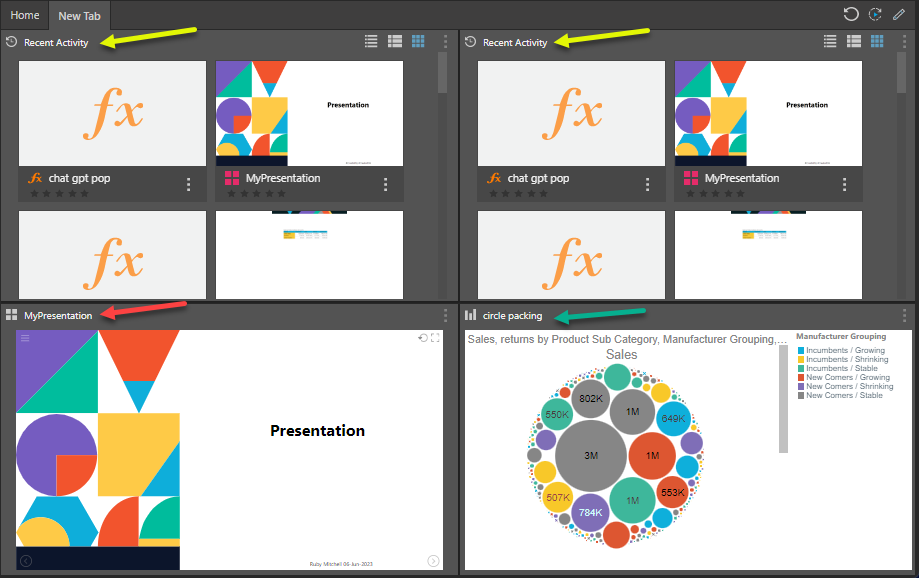
Widget Presets
The widget presets allow you to add various homepage and content manager views directly to the user hub. The content manager is the main toolset for working with content in the Pro client. It includes various views of the content system to enable users to find relevant content easily.
The following widget presets can be added to the hub:
- Favorites: a flat listing of all content items and folders that the user has flagged as their favorites.
- Recent Activity: a flat listing of all recently used content items by the current user.
- Tutorials: the in-app, interactive tutorials are designed to quickly give users hands-on experience with the application.
- Welcome: exposes the Quick Start and Learning Center Dialog which let Pro users quickly start new Model and Discover sessions or jump to the Content management tools.
- User Recommended: a flat listing of the top 20 most recommended content items.
- Bulletin Board: a viewer of all rendered publications and alerts earmarked for the user, their conversation threads and the status of any model processing jobs.
- Alerts: a list of rendered alert messages that have been posted to the user's "inbox"
- Publications: a list of rendered publication reports that have been posted to the user's "inbox"
- Subscriptions: a list of rendered subscription reports that have been posted to the user's "inbox"
- Models: a list of completed model processing jobs that have been triggered by the user.
- Workflows: displays all of a user's workflow and conversation threads. This includes threads initiated by the user, or those that have the user as a participant.
- URL:use the URL widget to load a URL in an iframe; paste a URL into the relevant field.
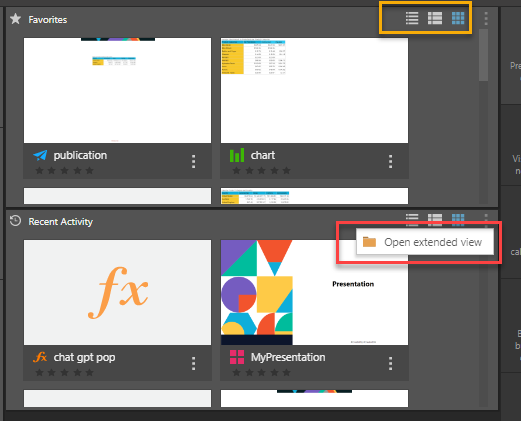
Widget Container Buttons
The widget preset containers expose the following functions:
- Display Listing: (orange highlight above) display the content items in the widget in a Details View, Content View, or Tile View. Click on an item in the listing to open it.
- Open Extended View: (red highlight above) open the given content view in the Content Manager.
Widget Content Items
Content items can be displayed within the widget presets or independently. When content items appear within the widget presets you can perform the following functions from the item's context menu (purple highlight below):
- View: (presentations only) open the presentation in view mode.
- Open: click on a content item to open it, or click Open from its context menu.
- Go to item location: click this button from the item's context menu to go to its location in the content explorer.
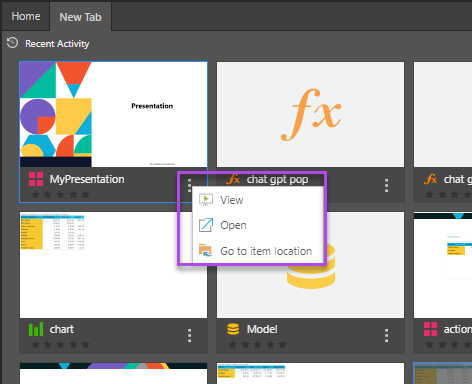
Interact with Data Discoveries and Presentations
Data discoveries and presentations can be added directly to the hub, to be displayed independently within their own container (not in a widget preset).
In this case, you can access a range of features via various context menus, which are exposed from the containers, the data visualizations, and the visualization backgrounds.
The context menu for the container is indicated by the 3 ellipses at the top right corner. Open it to access the following:
- Go to item location: go to the item's location in the content explorer.
- Open: open the item.
- View: (for presentations only) launch the presentation in runtime.
- Reset: reset the item to its most recently saved state.
- Re-Run Queries: run all queries in the item again.
- Full Screen: show the item in full screen mode.
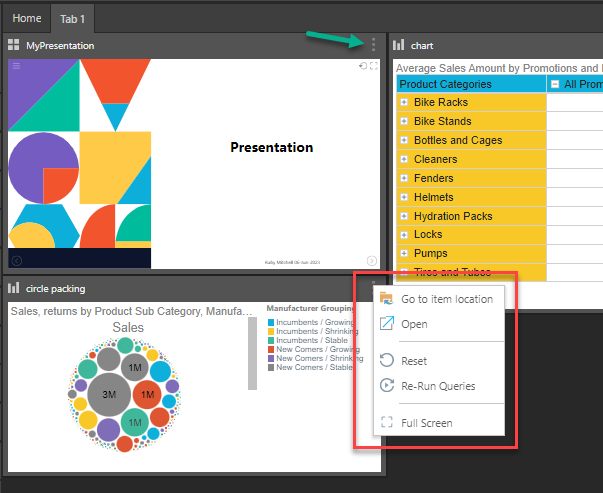
Right click the background of a data visualization to access the following functions.
- Totals: add or hide totals for grids.
- Pivot: auto-switch around the positions of hierarchies or values.
- Extended Operations: these features extend beyond typical data analysis, offering functionality that compliments and enhances the data analytics experience.
- Actions: execute actions that have been configured for a given hierarchy.
- Change Visual: display the query in a different visualization.
- Copy Content: copy the raw data or visual data from the discovery.
- Content Details: rate the report.
- Reset: reset the report to its most recently saved state.
- Full Screen: show the visualization in full screen mode.
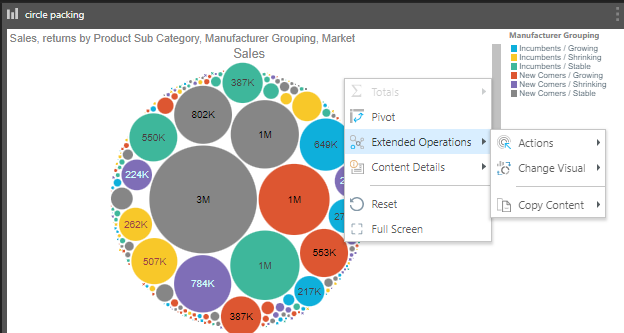
Right click on a data visualization itself to access the following:
- Dice: simultaneously filter the query by a given element while exposing an alternative selected hierarchy in its place in the visual and query.
- Drill: move between different levels of regular , parent-child and drill path hierarchies,
- Expand and Collapse: hide and show multiple levels of regular and drill path hierarchies in a grid visualization.
- Data Interactions: interact with your data and queries on-the-fly.
- Member Selection: easily and intuitively select elements and data points for analysis directly from visualizations.
- Swap, Add, Remove: inject, replace, or remove a selected hierarchy.
- Extended Operations: these features extend beyond typical data analysis, offering functionality that compliments and enhances the data analytics experience.
- Actions: execute actions that have been configured for a given hierarchy.
- Change Visual: display the query in a different visualization.
- Conditional Formatting: highlight important items in a visualization using mathematical or logical rules and graphical adjustments to the underlying chart or grid.
- Copy: copy raw data from the discovery.
- Reset: reset the discovery to its most recently saved state.
- Full Screen: show the visualization in full screen mode.
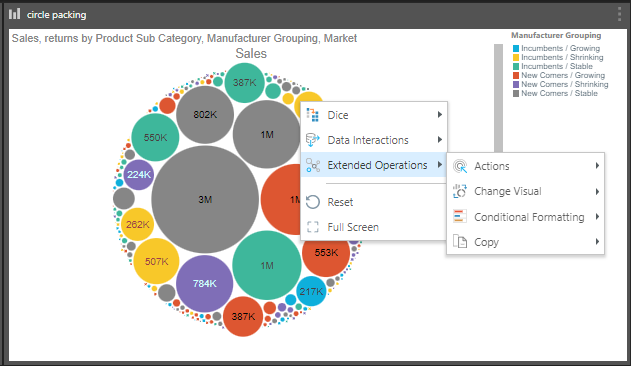
A streamlined selection of navigation tools is available for each presentation visual from the hub:
- Presentation Menu: open the presentation menu to re-run queries, and set slicers and bookmarks.
- Reset: reset the presentation to its most recently saved state.
- Full Screen Mode: show the presentation in full screen mode.
- Slide Navigation: navigate through the presentation slides.
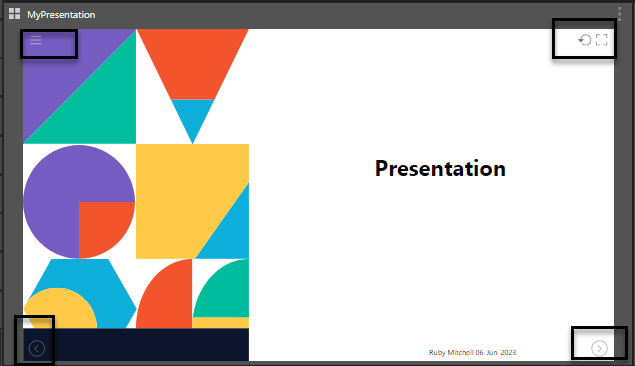
A streamlined selection of panel tools is available for each presentation visual from the hub:
- Smart Insights: generate AI-automated analysis of a given query, with the output returned in natural language.
- Chatbot: interact with visualizations in an intuitive way with plain English.
- Lasso and Auto Lasso Selection: define cross-visual interactions in order to pass values from one visual to another, via cross-filtering, or to highlight values across 2 or more visuals, via cross-highlighting.
- Full Screen: full-screen the specified visual.
